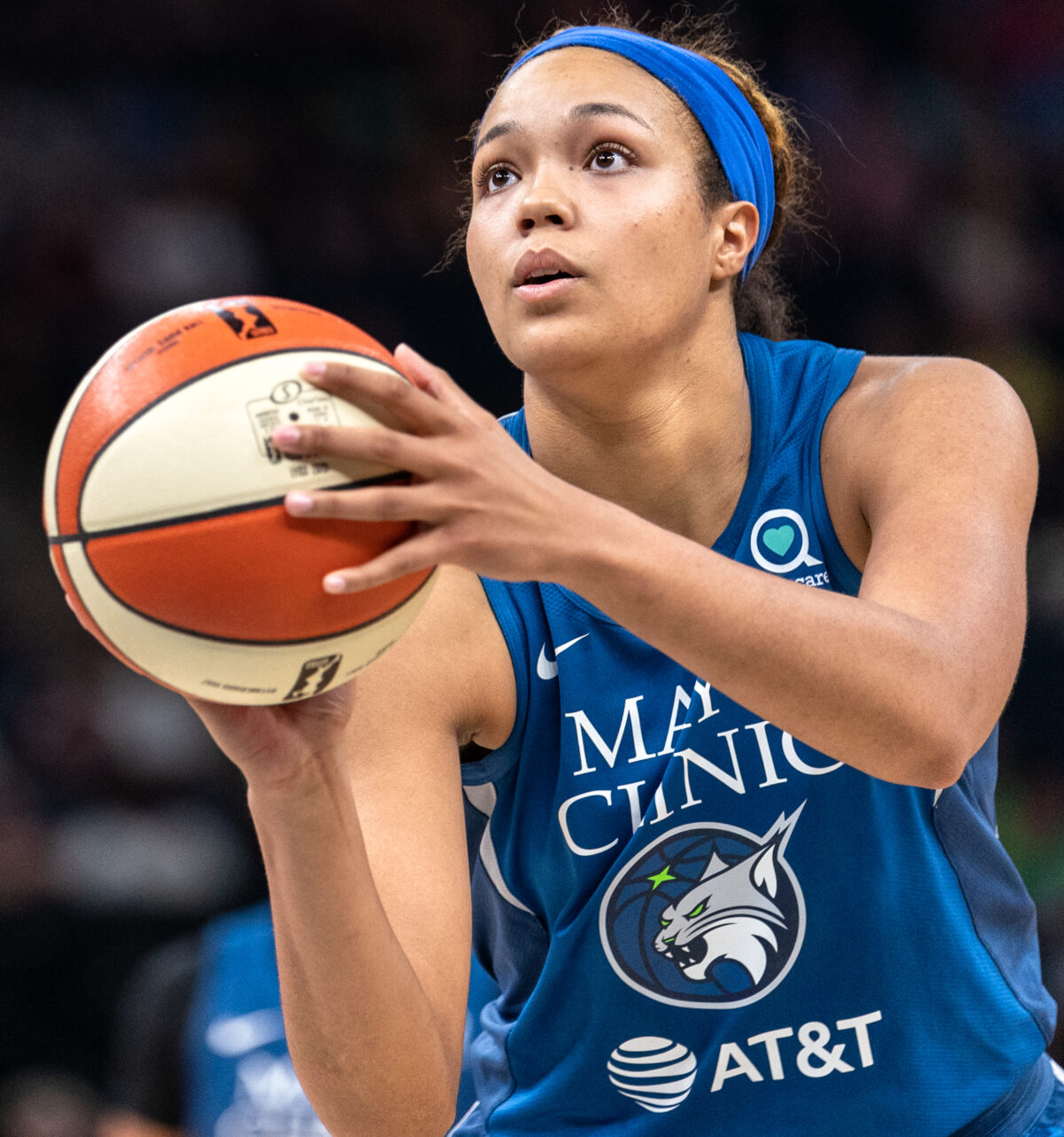
There’s a sequence in Napheesa Collier’s recent thirty-point game against the LA Sparks that tidily highlights the sort of perpetual, undercurrent threat she is. Barely three minutes into the first quarter, Collier seems to bolt out of nowhere to intercept a pass between the Sparks’ Layshia Clarendon and rookie Cameron Brink, rocketing the ball back down the court, uncontested, for an easy layup. Watch back in the lead-up to the steal and see Collier, who plays for the Minnesota Lynx, all coiled energy and at least three steps ahead of the sequence that’s about to play out.
The ball’s then passed off to Clarendon by Sparks forward Rickea Jackson as she’s pressed backward by the Lynx’s Bridget Carleton. The second Clarendon takes possession, Collier’s teammate Courtney Williams is on them, arms out and blanketing their view.
Throughout, Collier’s eyes never leave the ball—not when she picks up Brink and sets the 6’4” rookie on her hip, and not when she backs into the paint as the Sparks run a screen for Clarendon—and, opposite Williams’s statuesque stance, she’s been softly bouncing from the ball of her foot to her heel, as if revving up. Clarendon hesitates, deliberating who to pass to, but it’s clear Collier knows before they do. Partly because Williams has cut off many of Clarendon’s potential outlets, and partly because Collier, after shifting backwards into a zone defensive scheme, now has a wider perspective of the floor. It’s a smart move by Collier because she gives herself more room to watch where the ball will go and also lulls Williams and Brink into letting their guards down just enough to make the next split-second possible.
When Clarendon makes the pass to Brink, a light, eye-level lob, Collier has already lunged from the paint to deflect the ball, sending it down the court where she collects it in four strides, leaving Brink with her hands still outstretched.
Watching Collier run, unencumbered, from half-court to the net is not as exhilarating as it is familiar because the mechanics of her body appear unhurried and routine, even as she’s eating up the hardwood with each lengthening stride. This casualness is the beauty of, and an occasional detriment to, Collier’s game. It’s the reason she is one of the W’s top-tier players. She’s a stealth threat and a considerate teammate. She consistently knocks out record-setting games, but still, in her sixth season, has remained largely under the radar. Within the league, everyone knows about Collier. They know to keep the ball close when they get into the paint on an offensive possession, in case she swoops in; know to guard her just as tightly around the rim as they do way out past the three-point line. They know, too, that her body—just 6’1” tall but loaded with core strength—will push them around if they give her even an inch. This point was hammered home when Collier played against WNBPA president, league veteran, and Seattle Storm player Nneka Ogwumike. They had a series of in-game dust-ups earlier this month, which culminated in Collier coyly waving goodbye to Ogwumike just before the Lynx won the game. W fans reacted to this move with surprise, and even Ogwumike seemed startled. But maybe Collier’s done being subtle about what she can do.
*
Collier was born in O’Fallon, Missouri, a mid-sized suburb about forty miles from St. Louis. She went to high school two hours in the other direction, a stone’s throw from the Missouri River. (Here it is on Google Street View with a monster truck parked in the school lot.) Her grandfather, Gershon Collier, was a lawyer, an ambassador to the United Nations and the United States, and, briefly, the chief justice of Sierra Leone.
Growing up, she was surrounded by athletes. Her dad played rugby at Buckingham University in England; her uncle played baseball and basketball in college; and two of her cousins played basketball at the college level. Her dad would set Collier and her younger brother, Kai, against each other in backyard football scrimmages, drawing up elaborate plays for the two of them, during which Collier would space out, only to snap back once the ball did, putting her competitive track and field skills to work as she sprinted past her brother to jump for the catch.
When Collier first showed an interest in basketball, her parents tried to get her onto the only Amateur Athletic Union team in Jefferson City, but the team declined without letting her try out. Undeterred, her parents started their own team for her, ordering custom uniforms and inviting other girls in the area to join. That team, the Lady Warriors, made it into local tournaments, and the team that initially turned Collier down offered her a roster spot. She didn’t take it.
Heavily recruited by Division I colleges, Collier initially resisted the pull of UConn when they offered her a scholarship because she considered the choice to be too predictable. She didn’t want to join them, she wanted to beat them. She went on a campus visit anyway, and felt her position shift while hanging out with the undergrads, her future teammates, one night, playing board games and cracking jokes. Her early experience at UConn, Collier recalls, involved “learning an entire language.” It’s a sentiment she echoed when she was drafted by the Lynx and stood overwhelmed at the baseline during her first practice, unable to stop herself from laughing as plays she didn’t yet know were called out in rapid succession.
Thanks to her resolve and instant chemistry with veteran teammate Sylvia Fowles, Collier found her footing, fast. In her debut W game, she scored twenty-seven points, just falling short of the only other rookie record as high, thirty-four points made by Candace Parker in her 2008 debut. At the end of her rookie season Collier became the second rookie, after Tamika Catchings, to record 400 points, 200 rebounds, and sixty steals. Collier’s game accelerated during the time she spent abroad in her off-seasons—in Turkey, France, and, for a short time, China (before Covid shut down the WCBA and sent Collier home)— and gave her a sense of how dynamic her physicality could be.
Collier has always been strong, but she became stronger in Europe, where the leagues are stricter about contact among players than in American basketball. The result makes for a faster paced game, rife with blistering ball movement and pressurized ingenuity at the defensive end. Much of what she saw and learned there, she folded easily into her W game. Collier makes up for her not-so-towering height in muscle, which she uses to back down her defenders with ball- and head-fakes, torquing her body left and right while creating enough space between herself and the player guarding her, to get tricky shots off. She’s also an intuitive help defender. Slipping in on the defensive end to jam up the paint with her 6’6” wingspan, Collier frustrates her opponents’ ability to pass or shoot. Often, those she targets tend to give up, wilting under her raised arms and reaching hands as the shot clock runs out.
Collier was out most of the 2022 season on maternity leave after giving birth to her daughter. She’s been candid about the physical changes her body went through during pregnancy: “Your abs end up on [either] side of your body, so bringing those together was really hard.” Nevertheless, Collier pushed herself to return for a handful of that season’s games because she wanted to play with Fowles as much as she could before the veteran retired. In June the next season, Collier played a game where she put up thirty-one points, eight rebounds, five assists and six blocks, becoming the second player in WNBA history to finish a game with thirty-plus points, five-plus rebounds, five-plus assists, five-plus blocks.
For an athlete who tends toward quieter methods of putting in the work—Collier reads mystery novels to lock in before games—I wonder if her recent showboating and competitive in-game banter are the result of seeing others recognize her greatness. A real-time adjustment to a spotlight that was bound to swing her way eventually, given all she’s accomplished and all the accolades she is, at present, still racking up. We’re not even halfway through the 2024 season, and Collier has already becoming the first player in the league to ever score at least 115 points, manage fifty rebounds and twenty-five or more steals or blocks, plus twenty assists in any five-game stretch; she’s also a co-founder of Unrivaled (the new women’s pro three-on-three league) and headed to Paris for her second Olympics later this summer.
So the sequence in which Collier forces that turnover—an action so routine it often doesn’t end up in game highlights—feels to me like an indication of this turning point. Nothing about the game suggests anything extraordinary. The Lynx, who are at the top of the Western Conference, won handily against a team third to the bottom. A seasoned player took advantage of a rookie’s learning curve. It was Collier in her element, completely. But there was also a difference. Now, with so much momentum gathered, stored, and ready to erupt, Collier has finally broken out and is on her own. She is unobtrusive and then sublimely decisive in a snap, free from a tangle of both opponents and teammates to run, all eyes on her, without looking back.





